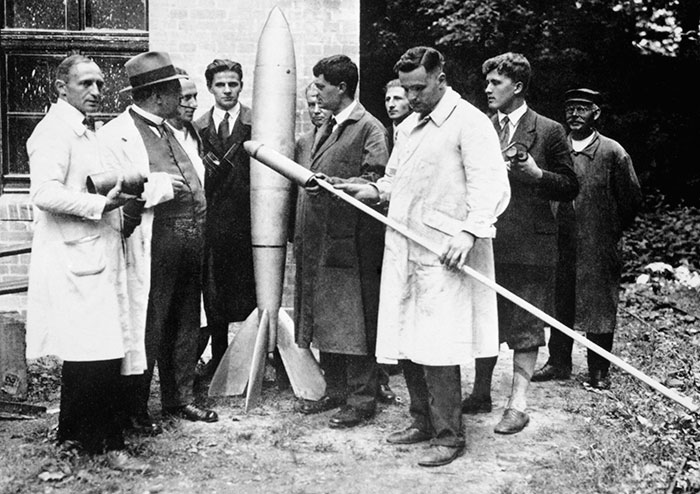
When the Babylonians practiced their astronomy during and after the First Babylonian Dynasty (c. 1830 BC), they were the first to use mathematics to predict astronomical phenomena. Not only that, they were also the first civilization with a theory of planetary movements. But they probably did not dream about vehicles moving between those planets.
When Edmond Halley, the renowned English astronomer, mathematician, and Professor of Geometry, predicted that certain comet sightings from the past were in fact of the same comet, and that this comet would be seen again in the year 1758, he did not comment on the possibility of travelling to comets, or other bodies in the solar system. And if such thoughts ever occurred to him, he surely kept them to himself.
It took about two centuries from then. Jules Verne dreamt of shooting a projectile to the moon in his 1865 novel From the Earth to the Moon. He got the mathematics about as right as he could, in an age where aether was still believed to be the medium in which one had to fly in interplanetary space. Hermann Oberth, fascinated by Verne, finally laid the mathematical groundwork and analysed the basic concepts of spacecraft movements based on Newtonian principles in his self-published book Die Rakete zu den Planetenräumen. A year before, in 1922, he submitted the same work as a doctoral dissertation, which then got rejected as ‘utopian’. Rocket science and space engineering surely had a rough start. However, the underlying mathematics had been put into place very early on by Oberth, Konstantin Tsiolkovsky and Robert H. Goddard, even if this was acknowledged properly only in due time.
Today rocket launches are regular events, executed with a success rate that almost makes them boring in our 24 hour news cycle. The year 2016 saw 85 launch attempts, with only six of them being unsuccessful. This ranks the year 2016 third in the current century in terms of launches, with 2014 (92 launches) and 2015 (87 launches) ahead. And each launch often carries several spacecraft: the record year 2014 had 240, followed by a further 221 in 2015. Currently, there are about 4,256 satellites in Earth orbit, although only around 1,419 are active. (Numbers are slightly uncertain here, as the status or mere existence of spacecraft managed by the defence sector often has to be inferred.) Add to this list a further 23 active craft and robots in interplanetary space or on the surface of Mars – the truly intrepid explorers, some of them as remote from Earth as humans have ever managed.
And space is big business: about a third of all launch activities are commercial, and global investment in commercial space activities is now above $50 billion, with clear indications towards further growth. Activities include telecommunication, Earth observation and imagery, navigation services, the fledgling space tourism sector, and several companies that explore mining the Moon and various asteroids. One of the quickest growing areas is the ‘downstream’ sector, in which Earth observation data, once downloaded from space, is merged with other data sources to provide one-stop services for agriculture, forestry, logistics, city management, and others. Earth observation and space-based telecommunication infrastructure helps in disaster management, earthquake forecasts, refugee relief, defence, management of environmental issues, and provides crucial information for forecasting climate change.
It is perhaps striking that since Oberth’s 1923 publication, all mission planning – be it for a simple launch into Earth orbit or an Earth-Moon transfer, or a complicated mission to the outer planets – follows the same mathematical principles. One either wants to move from point A to point B, or from one orbit to another one (possibly around a different celestial body), or from point A into a particular orbit, or vice versa.

Just like travelling on Earth, the important considerations are often either travel time, which should be as short as possible, or cost of travel, i.e. fuel costs, which in space engineering is usually conveniently measured by the amount of energy needed to finalise the envisioned manoeuvre. This is the realm of optimisation, a subfield of Operational Research (OR), often called ‘the science of the better’. As part of mathematical sciences, OR is one of the key technologies of space engineering and mission planning, and provides a common mathematical framework to identify the right problems and think about them in the right way, i.e. as design problems in which one wants to choose a certain design to optimise a certain criterion or measure of effectiveness. It was Oberth’s genius to start from Newton’s laws of motion and ask exactly the right questions to phrase the problem of moving a spacecraft from Earth into outer space as an optimisation problem, albeit implicitly.
Of course, optimisation does not stop here. Spacecraft and mission design in general is governed by principles of least cost, smallest effort, shortest mission times, lowest risk, maximum payload, and other criteria, and so optimisation permeates into all areas and stages of spacecraft and mission design: for example, any gram of weight saved in the design of a particular spacecraft part immediately provides an opportunity for a cheaper mission, or an opportunity to increase the weight of any scientific instruments on board. And so optimisation techniques have been used in the space industry for the design of heat pumps, the layout of spacecraft wirings, the scheduling of satellite-ground communications, the planning of space debris removal, and various other design problems.
This special issue of Mathematics Today is devoted to space, to the use of mathematics in humanity’s endeavour into space, and in particular to the use of Operational Research and optimisation in this feld. We have a number of exiting articles as follows.
Guillermo Ortega, Head of the Guidance, Navigation and Control Section of the European Space Agency, sets the stage with his contribution Mathematics to Build Space Missions, in which he provides a grand overview of how the European Space Agency uses ‘mathematical artillery’ to tackle the various problems engineers encounter when designing space missions.
Designing Interplanetary Transfers by Stephen Kemble from Airbus Defence and Space describes in detail the difficulties and vagaries of planning interplanetary missions, for example a mission that starts in Earth orbit and that, potentially via various gravity-assist manoeuvres at Venus, Earth, and Mars, brings a spacecraft after several years of travel time into Jupiter orbit.
Sören Geffken, Matthias Knauer, and Christof Büskens provide in Non-linear Optimisation in Space Engineering an overview of their solver WORHP (We Optimise Really Huge Problems), nowadays ESA’s software system of choice to tackle generic nonlinear optimisation problems. Again, it is breathtaking to see how wide a variety of problems can be solved within the framework of optimisation and Operational Research: from debris removal in Earth’s geostationary orbit to deep space mining, exploration of the sea below the ice crust of Saturn’s moon Enceladus, and beyond.
Optimising Resilience: at the Edge of Computability by Massimiliano Vasile, Professor of Space Systems Engineering at the Strathclyde Space Institute, discusses the role of uncertainty in space systems and optimisation in space engineering, and how to tackle it. As one might expect, optimising for the average case is not what one should do when planning missions to the planets.
We finish this special issue with the article Gravitational Waves: a New Window on the Universe by Ian Jones, Professor for Applied Mathematics at the University of Southampton and member of the LIGO (Laser Interferometer Gravitational-Wave Observatory) team that for the first time ever was able to detect gravitational waves of cosmic origin. The beautiful mathematics behind this discovery is described in this article, as well as what we should expect to see in the future: gravitational-wave observations as an astronomical tool.
Exiting times ahead!
Jörg Fliege
Guest Editor
University of Southampton
Reproduced from Mathematics Today, October 2017
Download the article, Editorial, October 2017 (pdf)



